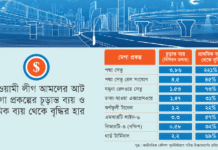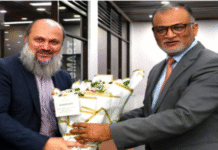
Prime Minister Sheikh Hasina on Wednesday directed the authorities concerned to go ahead for constructing the third terminal for the Hazrat Shahjalal International Airport (HSIA) as soon as possible to handle the mounting pressure of passengers.
The Prime Minister gave the directive at a meeting on a power-point presentation at her office on a preliminary feasibility study report and draft master plan to build the third terminal, second runway and other infrastructures for the airports.
The feasibility study report and the master plan have been formulated by a joint consulting firm.
PM’s Press Secretary AKM Shameem Chowdhuri briefed reporters after the meeting.
Speaking on the occasion, Sheikh Hasina mentioned Bangladesh must have a modern and big international airport considering the country’s geographical location.
She said Bangladesh could be a very important hub in terms of connectivity as the country is a bridge between the East and the West. “Bangladesh could play a crucial role in this regard.”
In this connection, Hasina listed her government’s various initiatives for the development of the country’s airports and said it was her government that constructed the second terminal at the Hazrat Shahjalal International Airport.
Besides, the Prime Minister said her government also upgraded the Sylhet Osmani and Chittagong Shah Amanat airports to international ones.
She said steps have also been taken to transform Cox’s Bazar and Syedpur Airports into international standards. “Ishwardi Airport will also have to be developed further.”
On completion of the works, the Prime Minister said, these airports would play a very significant role in strengthening connectivity with the outside world.
Official sources said the annual passenger handling capacity of the HSIA is about eight millions. In the current fiscal year, some 6.7 million passengers used the airport, showing an increasing rate of 9.5 percent.
They said the number of passengers at the airport would cross eight millions in 2018. So, there will be a need for constructing a new terminal in 2019 for handling of the increased passengers.
They said though the annual cargo handling capacity of the airport is two lakh tonnes, presently 2.37 lakh tonnes of cargo are transported through the airport. That means the airport is handling 18 percent more cargo than the present capacity.
A joint consulting firm, comprising Yushin of Korea, CPG of Singpapore and DDC of Bangladesh, has been appointed to formulate a master plan for constructing necessary infrastructures to fulfill the demand of growing passengers and cargoes.
The firm conducted the feasibility study and a new master plan for the airport expansion project for 10 months.
As per the master plan, a proposal has been made to complete the airport expansion work in two phases.
The master plan has proposed constructing all infrastructures excepting the second runway in the first phase. The infrastructures include third terminal, cargo village, VVIP complex and domestic terminal.
The first phase work will start this year and complete by 2019, which will require Tk 10,700 crore. In the second phase, a proposal for constructing other infrastructures, including the second runway, has been made and their approximate cost would be Tk 2,300 crore.
As per the feasibility study, the implementation of the second phase work could be reevaluated by considering the situation after completing the first phase work.
The study report said it is very essential to expand the HSIA as the country’s prime international airport. In the light of the feasibility study, the Civil Aviation Authority, Bangladesh (CAAB) has recommended implementation of the first phase expansion as soon as possible.
Besides, the CAAB thinks that starting of the work of Bangabandhu International Airport just now is logical side by side with finishing the first phase expansion work of the HSIA.
Civil Aviation and Tourism Minister Rashed Khan Menon, Secretary of the Ministry Khorshed Alam Chowdhury and CAAB Chairman Air-Vice Marshal M Sanaul Haq were, among others, present at the meeting.
Source: UNB









